Curriculum Design Made Easy
Explore curriculum design strategies that create meaningful, connected learning, support critical thinking, and enhance student engagement.


Explore curriculum design strategies that create meaningful, connected learning, support critical thinking, and enhance student engagement.
Curriculum design can often feel daunting, yet it is a fundamental aspect of effective education. With the right approach and tools, transforming your educational vision into a structured curriculum is not only achievable but also rewarding. Understanding the nuances of curriculum design is essential for educators striving for excellence in teaching.
Curriculum design encompasses various definitions, methodologies, and models crucial to delivering an impactful educational experience. Distinguishing between curriculum development and design can significantly affect how educational programs are perceived and implemented. By recognizing the importance of different curriculum models, such as subject-centered, learner-centered, and problem-centered approaches, educators can create engaging and responsive learning environments.
This article offers a streamlined guide to mastering curriculum design through practical steps, valuable tips, and evaluation strategies. Whether you are a seasoned educator or just starting, these insights will enable teachers to simplify the curriculum design process and enhance the classroom activities of your students.
Curriculum design is the process of organizing educational content, activities, and assessments for a course or class. It involves setting clear learning goals and aligning materials to achieve desired learning outcomes. This structured approach helps meet students' needs through subject-centered, learner-centered, or problem-centered designs.
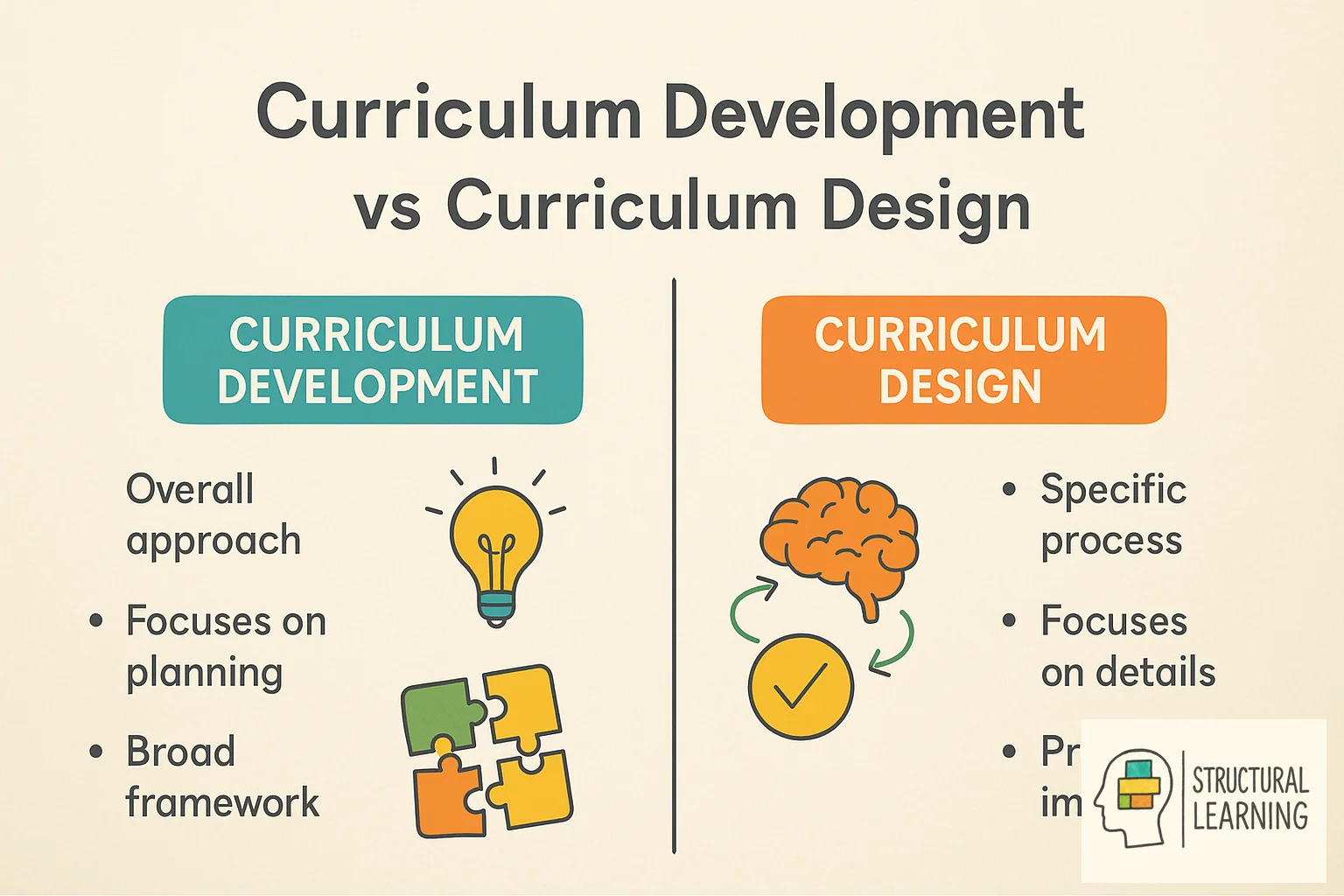
Subject-centered curriculum design primarily focuses on specific subject matter, ensuring that content is thoroughly covered. Learner-centered designs prioritize individual student engagement, tailoring lessons to students' needs and interests. Problem-centered designs emphasize real-world problems, encouraging critical thinking and problem-solving skills.

Curriculum development serves as the framework for an educational program. Curriculum design translates this into practical, actionable formats, facilitating the daily organization of lessons and instructional materials. This structured method ensures that educators effectively achieve learning objectives, using tailored instructional strategies and technology.
Key goals in curriculum design include a focus on student engagement, continuous improvement, and the clear organization of activities across whole-school systems and beyond. These elements collectively enhance the educational experience for students, preparing them for future academic or professional endeavors.
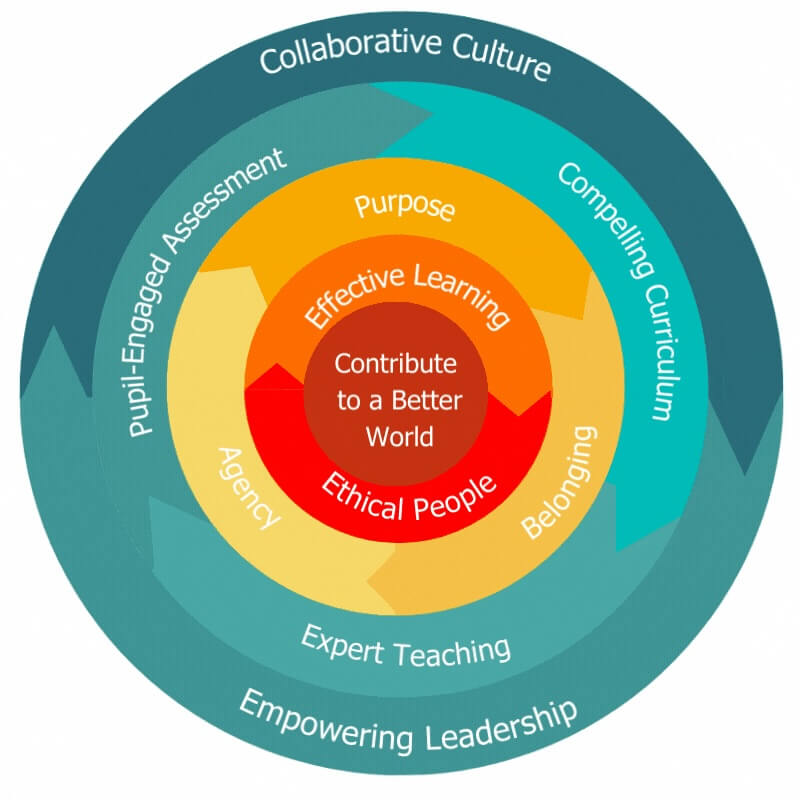
Curriculum development and curriculum design are often used interchangeably but have distinct roles in education. Curriculum development involves the comprehensive creation of a curriculum that aligns with educational goals and the institution's mission. It encompasses planning, implementation, and evaluation phases, focusing on key learning outcomes, content selection, and course sequencing.

On the other hand, curriculum design is more tactical and focuses on the organizational plan for educators. It involves structuring courses and crafting lesson plans to enhance student learning. While curriculum development covers the broad conceptual framework, curriculum design aims at improving the delivery of education by considering past and future subjects students will learn.
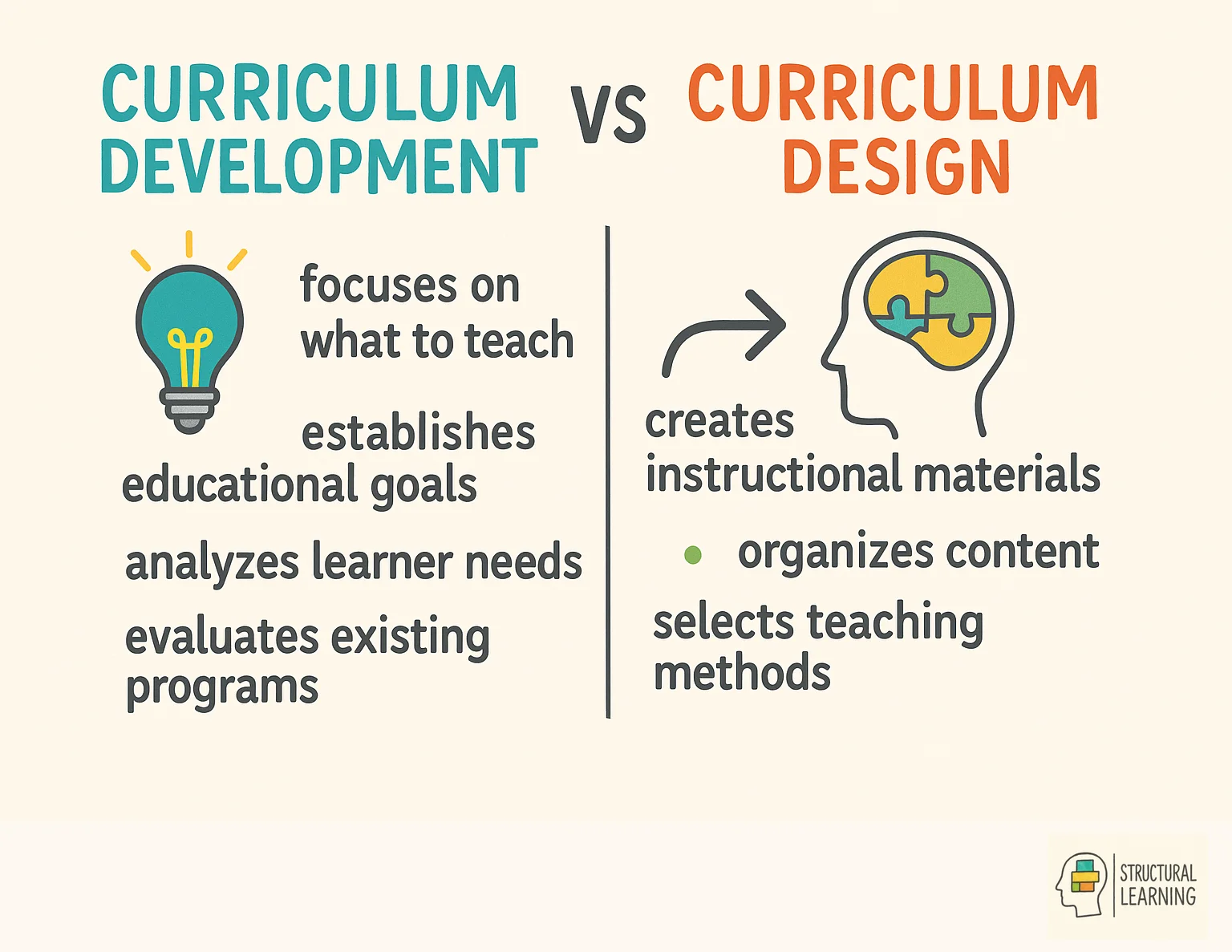
In summary, curriculum development sets the strategic foundation, whereas curriculum design fine-tunes the educational structure to optimize lessons. Both are essential for crafting effective educational programs but operate at different stages of the curriculum process.
Curriculum models provide a structured approach to curriculum design, serving as essential guides for educators during creation and implementation. Prescriptive models target the goals of a curriculum, outlining what curriculum designers should achieve. Descriptive models, conversely, showcase the practical activities and strategies employed during development. These models ensure that elements like content, teaching strategies, assessments, and evaluations are cohesively integrated, ultimately enhancing student learning outcomes. By understanding and employing different curriculum models, educators can tailor their frameworks to meet evolving educational needs.
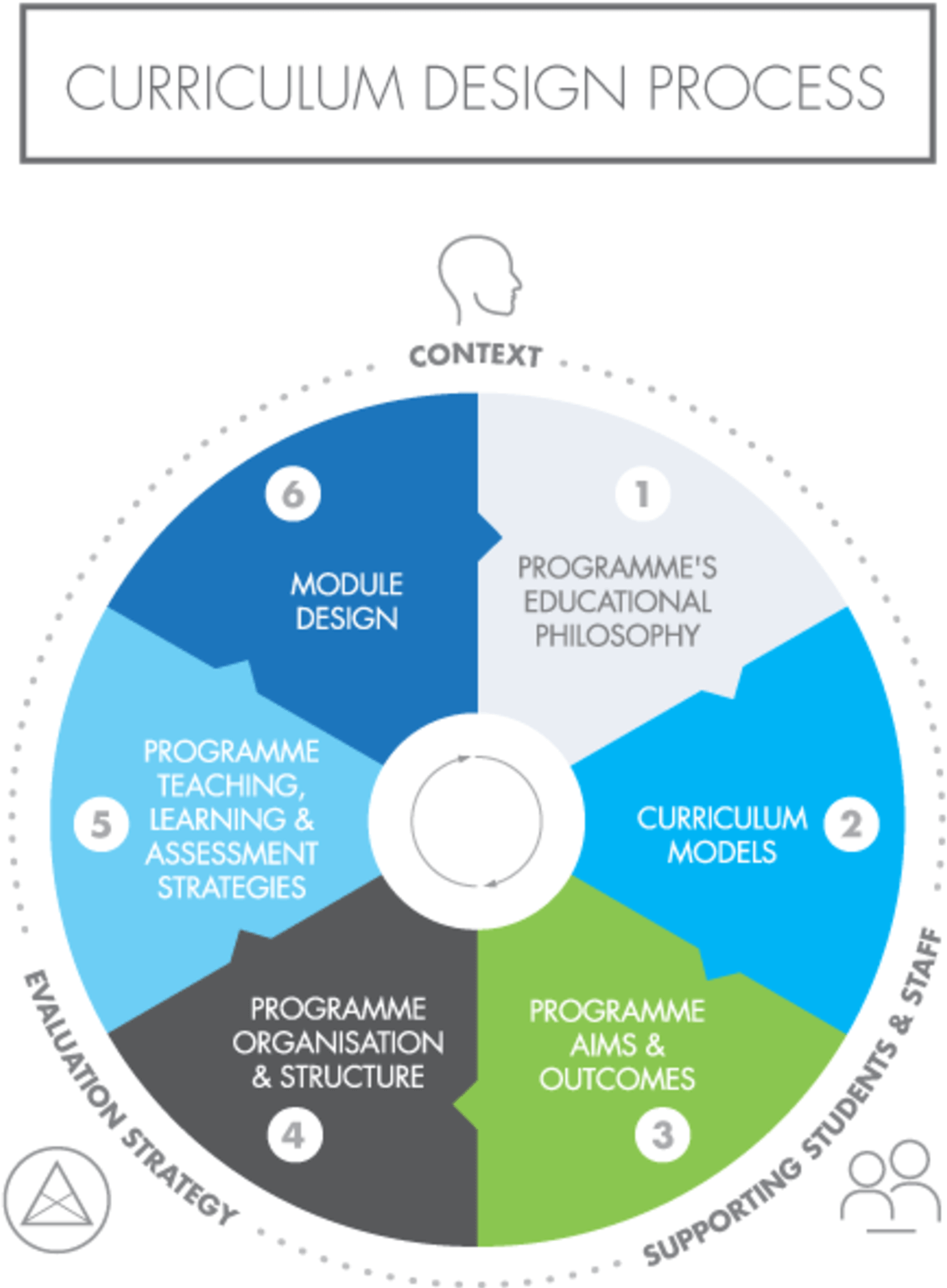
Subject-centered curriculum design emphasizes specific subjects or disciplines, such as math or science, often found in K-12 public schools. Teachers follow predetermined lists detailing what to teach and standardized methodologies. While effective for whole-group instruction, it is essential to incorporate diverse materials and resources to accommodate various learning styles*. This model is prevalent in both K-12 settings and large university classes, with a primary focus on the subject matter rather than the individual learner.
Learner-centered curriculum design prioritizes individual student needs, interests, and goals, eschewing a one-size-fits-all approach. Instructional plans are differentiated, allowing students to choose assignments and activities that engage them. This empowers learners to take ownership of their education, fostering greater motivation and engagement. Although the approach is effective, especially for students with specialized needs, it can be resource-intensive, necessitating custom-tailored materials.
Problem-centered curriculum design immerses students in real-life issues, promoting authentic lessons. This model enhances curriculum relevance by encouraging creativity and collaboration as students address problems and develop solutions. Students benefit by honing decision-making skills and the ability to apply learned skills to real-world situations. However, it may not accommodate all learning styles. Schools often integrate problem-centered design with other models to create adaptive learning environments that meet diverse student needs.
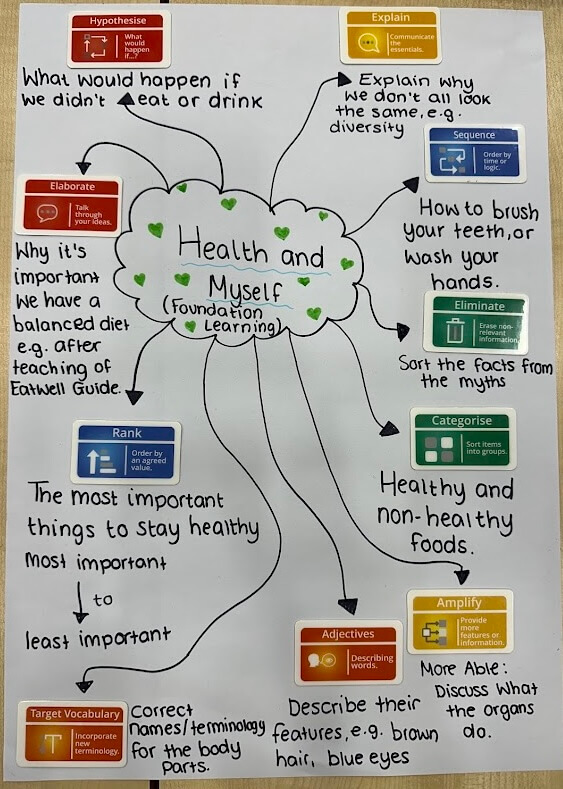
Embedding critical thinking and problem-solving within curriculum design is essential for fostering higher-order thinking skills across subject areas.
By incorporating strategies that encourage metacognition, reflection, and active exploration, educators can support teachers in developing the tools necessary for lifelong learning. Utilizing instructional design elements and educational technology, teachers can build activities that align with frameworks like Webb's Depth of Knowledge.
Through hands-on activities inspired by Vygotsky's social learning theories, students can navigate complex tasks collaboratively, deepening their understanding through shared thinking processes.
Finding the balance between breadth and depth in subject matter is a perennial challenge in curriculum design, especially in secondary schools and middle school settings. This balance goes to the heart of the philosophy of education, as it speaks to the purpose of instruction: are we aiming to cultivate well-rounded learners, or are we creating specialists? Both approaches have merit, yet effective curriculum design tips suggest the answer may lie in a nuanced blend.
A curriculum focused purely on breadth risks fostering superficial knowledge; students may touch upon many topics but lack the depth needed to apply or synthesize ideas meaningfully. Conversely, a curriculum overly focused on depth can result in narrow expertise, leaving learners underprepared for real-world complexity. To achieve balance, education institutions should prioritize "coherent instruction," weaving broad themes with selective deep dives that anchor activities across disciplines. This approach aligns with types of curriculum design that value both conceptual frameworks and focused exploration.
For practical implementation, Knowledge Organizers and flipped teaching techniques offer pathways to deepen engagement with content while ensuring foundational breadth. Knowledge Organizers provide a scaffold for secondary school students to grasp essential facts and concepts, while flipped teaching shifts instruction out of the classroom, enabling learners to interact deeply with material at their own pace and later apply it through guided, collaborative work.
The challenge is not just in structuring lessons but also in cultivating "knowledge of content" and "knowledge of resources" among educators. Philosophical models like P4C (Philosophy for Children) encourage learners to ask fundamental questions, promoting progress in learning through reflective and critical inquiry.
By combining breadth and depth within instructional strategies, educators can guide students toward a balanced curriculum, one that provides expansive knowledge, encourages inquiry, and supports sustained engagement with complex ideas, thus fostering a rich and adaptable foundation for lifelong learning.
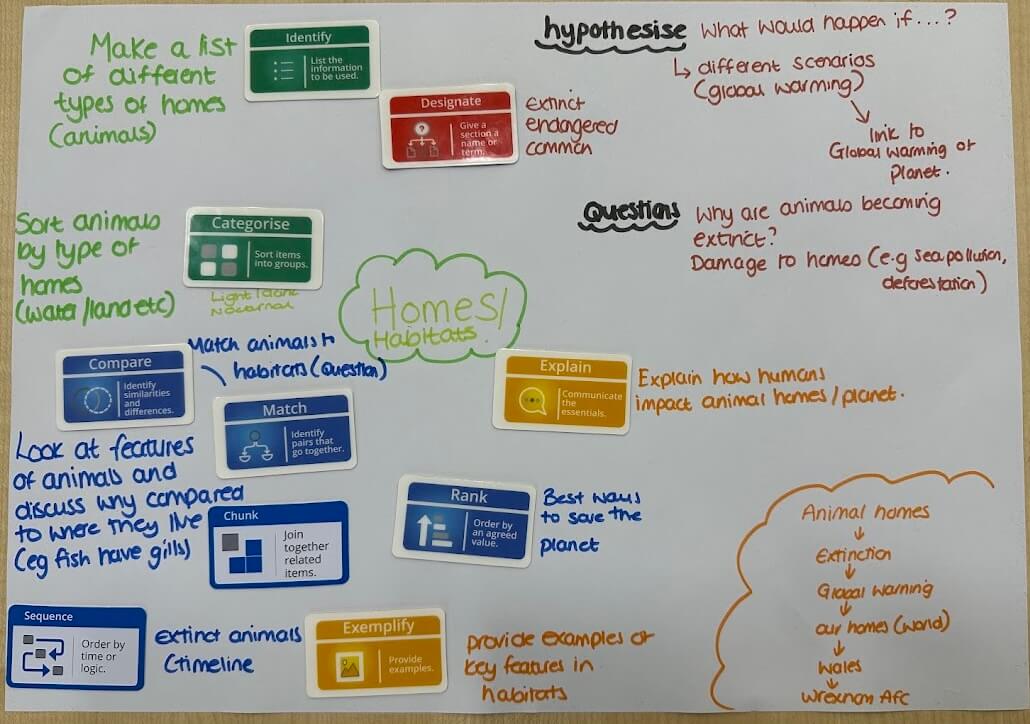
Designing a curriculum that truly engages students requires thoughtful planning and flexibility to address varied learning needs and interests. The thinking framework gives teachers powerful tools to design structured learning journeys that make curriculum content accessible and relevant for all learners.
By applying principles like learner-centered and subject-centered design, teachers can create pathways that connect students more meaningfully to core curriculum content. Here's how the thinking framework can enhance engagement, support differentiation, and meet diverse educational needs.
By integrating the thinking framework into curriculum design, teachers create structured, differentiated, and engaging learning journeys. This approach not only enhances students' mastery of subject-centered knowledge but also ensures that each element of curriculum design, from planning and organization to delivery, supports meaningful, student-centered lessons.
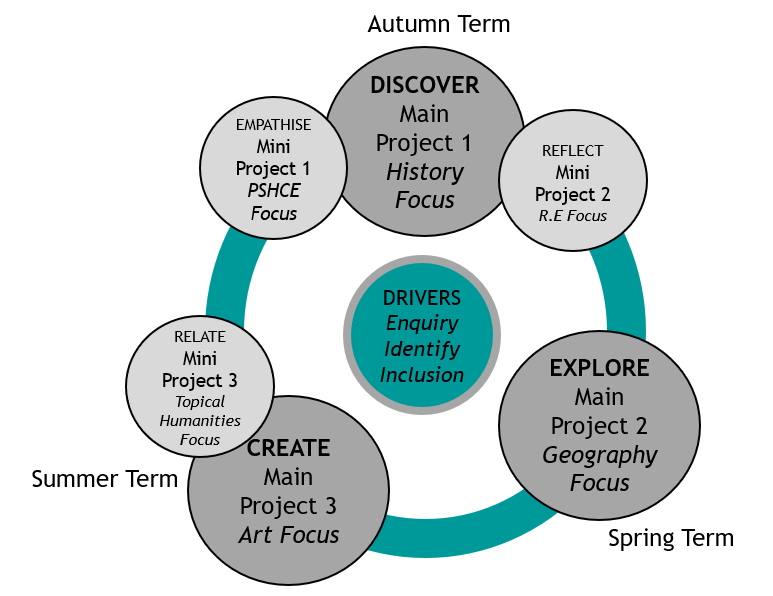
Evaluating curriculum effectiveness is crucial to ensure that learning outcomes are met. Ongoing assessment methods should be established throughout the school year to continuously evaluate learners, instructors, and the curriculum itself. This supports teachers in identifying strengths and weaknesses, measuring achievement rates, and ensuring continuous improvement in educational programs.
Curriculum design should include a built-in mechanism for periodic assessment and refinement. Collecting and analyzing assessment data enables teachers to make informed adjustments to instructional strategies and materials. These adjustments are essential for maintaining student engagement and achieving desired learning objectives.
Both ongoing and summative evaluations are vital for gauging a curriculum's effectiveness. While ongoing evaluations provide immediate feedback and allow teachers to make timely corrections, summative evaluations offer a comprehensive view at the end of the instructional period. The combination of these evaluation approaches ensures that curricular revisions are timely and evidence-based, thereby enhancing the overall educational experience for individual students.
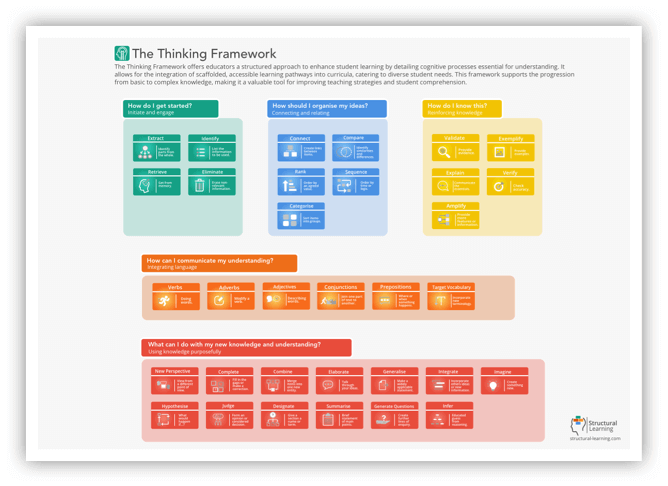
Continuous improvement is crucial in curriculum design. It involves periodic assessment and refinement based on evaluation data to effectively meet learning outcomes. Regular evaluation throughout the school year allows teachers to identify curriculum strengths and areas needing enhancement.
Modifications may be necessary partway through a course to ensure proficiency by the instructional period's end. Encouraging teachers and students to suggest improvements to lessons and materials initiates a cycle of continuous development. This collaborative approach fosters active involvement in refining educational programs.
Recognizing curriculum design as an evolving process rather than a one-time event supports teachers in committing to making lasting changes. By embracing this mindset, educators can implement strategies that benefit student learning and improve instructional materials. Consistent updates and responsiveness to feedback ensure the curriculum remains relevant and effective.
Key Steps for Continuous Improvement:
These steps ensure continuous development in the curriculum design process, ultimately leading to enhanced student engagement and learning outcomes.

Here are five key studies on best practices in curriculum design for schools and colleges, highlighting the role of structured models, expert contributions, and alignment with student learning needs. These studies illustrate effective strategies that curriculum specialists, writers, and educators can use to enhance instructional coherence, student engagement, and overall educational quality.
1. Backward Design Model Comparison
A study comparing the backward design model with traditional curriculum design approaches in teacher education found that preservice teachers using the backward design model outperformed those using traditional models. Key areas of improvement included knowledge of students, instructional coherence, and overall curriculum effectiveness (Kelting-Gibson, 2005).
2. Curriculum Mapping for Improvement
Curriculum mapping has been identified as a valuable tool for integrating courses and ensuring coherence, particularly in Information Systems education. This technique allows teachers to visualize and structure activities, thereby enhancing alignment with program outcomes and promoting student knowledge growth (Veltri et al., 2011).
3. Best Practices in Engineering Curriculum Design
This research offers a framework for structuring undergraduate engineering curriculum, emphasizing interactive learning, self-directed assignments, and real-world problem-solving. These components are essential for engaging students and fostering deeper lessons (Das et al., 2015).
4. Learning Analytics for Course Redesign
Examining the role of learning analytics in course redesign, this study outlines how data-driven insights can support curriculum adjustments that better address institutional and student needs, especially in large-scale online course formats (Morse, 2014).
5. Course System Reform in Teachers' Colleges
This study discusses a curriculum reform approach that emphasizes comprehensive practice activities in teacher training, aiming to bridge theory and practice. The approach is tailored to enhance teachers' readiness to meet elementary education curriculum demands (Hong-lin, 2015).
Each of these studies reinforces the value of structured design models and responsive curriculum strategies in creating effective educational programs.
Curriculum design can often feel daunting, yet it is a fundamental aspect of effective education. With the right approach and tools, transforming your educational vision into a structured curriculum is not only achievable but also rewarding. Understanding the nuances of curriculum design is essential for educators striving for excellence in teaching.
Curriculum design encompasses various definitions, methodologies, and models crucial to delivering an impactful educational experience. Distinguishing between curriculum development and design can significantly affect how educational programs are perceived and implemented. By recognizing the importance of different curriculum models, such as subject-centered, learner-centered, and problem-centered approaches, educators can create engaging and responsive learning environments.
This article offers a streamlined guide to mastering curriculum design through practical steps, valuable tips, and evaluation strategies. Whether you are a seasoned educator or just starting, these insights will enable teachers to simplify the curriculum design process and enhance the classroom activities of your students.
Curriculum design is the process of organizing educational content, activities, and assessments for a course or class. It involves setting clear learning goals and aligning materials to achieve desired learning outcomes. This structured approach helps meet students' needs through subject-centered, learner-centered, or problem-centered designs.

Subject-centered curriculum design primarily focuses on specific subject matter, ensuring that content is thoroughly covered. Learner-centered designs prioritize individual student engagement, tailoring lessons to students' needs and interests. Problem-centered designs emphasize real-world problems, encouraging critical thinking and problem-solving skills.

Curriculum development serves as the framework for an educational program. Curriculum design translates this into practical, actionable formats, facilitating the daily organization of lessons and instructional materials. This structured method ensures that educators effectively achieve learning objectives, using tailored instructional strategies and technology.
Key goals in curriculum design include a focus on student engagement, continuous improvement, and the clear organization of activities across whole-school systems and beyond. These elements collectively enhance the educational experience for students, preparing them for future academic or professional endeavors.

Curriculum development and curriculum design are often used interchangeably but have distinct roles in education. Curriculum development involves the comprehensive creation of a curriculum that aligns with educational goals and the institution's mission. It encompasses planning, implementation, and evaluation phases, focusing on key learning outcomes, content selection, and course sequencing.

On the other hand, curriculum design is more tactical and focuses on the organizational plan for educators. It involves structuring courses and crafting lesson plans to enhance student learning. While curriculum development covers the broad conceptual framework, curriculum design aims at improving the delivery of education by considering past and future subjects students will learn.

In summary, curriculum development sets the strategic foundation, whereas curriculum design fine-tunes the educational structure to optimize lessons. Both are essential for crafting effective educational programs but operate at different stages of the curriculum process.
Curriculum models provide a structured approach to curriculum design, serving as essential guides for educators during creation and implementation. Prescriptive models target the goals of a curriculum, outlining what curriculum designers should achieve. Descriptive models, conversely, showcase the practical activities and strategies employed during development. These models ensure that elements like content, teaching strategies, assessments, and evaluations are cohesively integrated, ultimately enhancing student learning outcomes. By understanding and employing different curriculum models, educators can tailor their frameworks to meet evolving educational needs.

Subject-centered curriculum design emphasizes specific subjects or disciplines, such as math or science, often found in K-12 public schools. Teachers follow predetermined lists detailing what to teach and standardized methodologies. While effective for whole-group instruction, it is essential to incorporate diverse materials and resources to accommodate various learning styles*. This model is prevalent in both K-12 settings and large university classes, with a primary focus on the subject matter rather than the individual learner.
Learner-centered curriculum design prioritizes individual student needs, interests, and goals, eschewing a one-size-fits-all approach. Instructional plans are differentiated, allowing students to choose assignments and activities that engage them. This empowers learners to take ownership of their education, fostering greater motivation and engagement. Although the approach is effective, especially for students with specialized needs, it can be resource-intensive, necessitating custom-tailored materials.
Problem-centered curriculum design immerses students in real-life issues, promoting authentic lessons. This model enhances curriculum relevance by encouraging creativity and collaboration as students address problems and develop solutions. Students benefit by honing decision-making skills and the ability to apply learned skills to real-world situations. However, it may not accommodate all learning styles. Schools often integrate problem-centered design with other models to create adaptive learning environments that meet diverse student needs.

Embedding critical thinking and problem-solving within curriculum design is essential for fostering higher-order thinking skills across subject areas.
By incorporating strategies that encourage metacognition, reflection, and active exploration, educators can support teachers in developing the tools necessary for lifelong learning. Utilizing instructional design elements and educational technology, teachers can build activities that align with frameworks like Webb's Depth of Knowledge.
Through hands-on activities inspired by Vygotsky's social learning theories, students can navigate complex tasks collaboratively, deepening their understanding through shared thinking processes.
Finding the balance between breadth and depth in subject matter is a perennial challenge in curriculum design, especially in secondary schools and middle school settings. This balance goes to the heart of the philosophy of education, as it speaks to the purpose of instruction: are we aiming to cultivate well-rounded learners, or are we creating specialists? Both approaches have merit, yet effective curriculum design tips suggest the answer may lie in a nuanced blend.
A curriculum focused purely on breadth risks fostering superficial knowledge; students may touch upon many topics but lack the depth needed to apply or synthesize ideas meaningfully. Conversely, a curriculum overly focused on depth can result in narrow expertise, leaving learners underprepared for real-world complexity. To achieve balance, education institutions should prioritize "coherent instruction," weaving broad themes with selective deep dives that anchor activities across disciplines. This approach aligns with types of curriculum design that value both conceptual frameworks and focused exploration.
For practical implementation, Knowledge Organizers and flipped teaching techniques offer pathways to deepen engagement with content while ensuring foundational breadth. Knowledge Organizers provide a scaffold for secondary school students to grasp essential facts and concepts, while flipped teaching shifts instruction out of the classroom, enabling learners to interact deeply with material at their own pace and later apply it through guided, collaborative work.
The challenge is not just in structuring lessons but also in cultivating "knowledge of content" and "knowledge of resources" among educators. Philosophical models like P4C (Philosophy for Children) encourage learners to ask fundamental questions, promoting progress in learning through reflective and critical inquiry.
By combining breadth and depth within instructional strategies, educators can guide students toward a balanced curriculum, one that provides expansive knowledge, encourages inquiry, and supports sustained engagement with complex ideas, thus fostering a rich and adaptable foundation for lifelong learning.

Designing a curriculum that truly engages students requires thoughtful planning and flexibility to address varied learning needs and interests. The thinking framework gives teachers powerful tools to design structured learning journeys that make curriculum content accessible and relevant for all learners.
By applying principles like learner-centered and subject-centered design, teachers can create pathways that connect students more meaningfully to core curriculum content. Here's how the thinking framework can enhance engagement, support differentiation, and meet diverse educational needs.
By integrating the thinking framework into curriculum design, teachers create structured, differentiated, and engaging learning journeys. This approach not only enhances students' mastery of subject-centered knowledge but also ensures that each element of curriculum design, from planning and organization to delivery, supports meaningful, student-centered lessons.

Evaluating curriculum effectiveness is crucial to ensure that learning outcomes are met. Ongoing assessment methods should be established throughout the school year to continuously evaluate learners, instructors, and the curriculum itself. This supports teachers in identifying strengths and weaknesses, measuring achievement rates, and ensuring continuous improvement in educational programs.
Curriculum design should include a built-in mechanism for periodic assessment and refinement. Collecting and analyzing assessment data enables teachers to make informed adjustments to instructional strategies and materials. These adjustments are essential for maintaining student engagement and achieving desired learning objectives.
Both ongoing and summative evaluations are vital for gauging a curriculum's effectiveness. While ongoing evaluations provide immediate feedback and allow teachers to make timely corrections, summative evaluations offer a comprehensive view at the end of the instructional period. The combination of these evaluation approaches ensures that curricular revisions are timely and evidence-based, thereby enhancing the overall educational experience for individual students.

Continuous improvement is crucial in curriculum design. It involves periodic assessment and refinement based on evaluation data to effectively meet learning outcomes. Regular evaluation throughout the school year allows teachers to identify curriculum strengths and areas needing enhancement.
Modifications may be necessary partway through a course to ensure proficiency by the instructional period's end. Encouraging teachers and students to suggest improvements to lessons and materials initiates a cycle of continuous development. This collaborative approach fosters active involvement in refining educational programs.
Recognizing curriculum design as an evolving process rather than a one-time event supports teachers in committing to making lasting changes. By embracing this mindset, educators can implement strategies that benefit student learning and improve instructional materials. Consistent updates and responsiveness to feedback ensure the curriculum remains relevant and effective.
Key Steps for Continuous Improvement:
These steps ensure continuous development in the curriculum design process, ultimately leading to enhanced student engagement and learning outcomes.

Here are five key studies on best practices in curriculum design for schools and colleges, highlighting the role of structured models, expert contributions, and alignment with student learning needs. These studies illustrate effective strategies that curriculum specialists, writers, and educators can use to enhance instructional coherence, student engagement, and overall educational quality.
1. Backward Design Model Comparison
A study comparing the backward design model with traditional curriculum design approaches in teacher education found that preservice teachers using the backward design model outperformed those using traditional models. Key areas of improvement included knowledge of students, instructional coherence, and overall curriculum effectiveness (Kelting-Gibson, 2005).
2. Curriculum Mapping for Improvement
Curriculum mapping has been identified as a valuable tool for integrating courses and ensuring coherence, particularly in Information Systems education. This technique allows teachers to visualize and structure activities, thereby enhancing alignment with program outcomes and promoting student knowledge growth (Veltri et al., 2011).
3. Best Practices in Engineering Curriculum Design
This research offers a framework for structuring undergraduate engineering curriculum, emphasizing interactive learning, self-directed assignments, and real-world problem-solving. These components are essential for engaging students and fostering deeper lessons (Das et al., 2015).
4. Learning Analytics for Course Redesign
Examining the role of learning analytics in course redesign, this study outlines how data-driven insights can support curriculum adjustments that better address institutional and student needs, especially in large-scale online course formats (Morse, 2014).
5. Course System Reform in Teachers' Colleges
This study discusses a curriculum reform approach that emphasizes comprehensive practice activities in teacher training, aiming to bridge theory and practice. The approach is tailored to enhance teachers' readiness to meet elementary education curriculum demands (Hong-lin, 2015).
Each of these studies reinforces the value of structured design models and responsive curriculum strategies in creating effective educational programs.